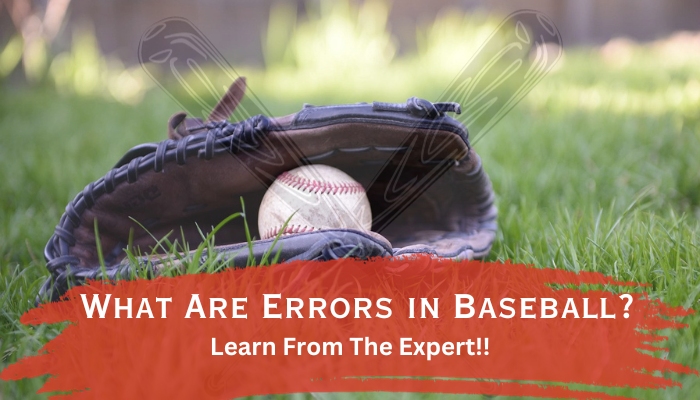Baseball errors are the mistakes by the fielders that directly benefit the batter or the baserunner.
To be honest, I’ve made all the errors you can name in baseball in my career. In addition, this is one of the most common queries I get from my students.
Hence, I thought, why don’t I make a resource that will help my students along with all other baseball enthusiasts who have this question in mind?
So, here you have it. This article will answer all your questions regarding errors in baseball. This guide includes the error types, their consequences, their effects on other baseball stats, tips to reduce errors, and whatnot.
Let’s jump right into the business!
What Is An Error In Baseball?
A baseball error is when a fielder makes a mistake that allows a batter or runner to advance or reach base or allows a plate appearance to continue. It’s like a mistake that directly helps the team at bat.

In simple terms, to score an error in baseball, you should miss something that you shouldn’t with ordinary effort. But if it’s a crazy hard play and you can’t quite get to it, it’s not your fault, and it will not be called an error.
Imagine you’re out there on the field, maybe playing as a shortstop. A batter hits a ground ball your way. If that ground ball is something you could reasonably handle, but you miss it or fumble with it, that’s an error.
This means an error will be assigned if you make a mistake for a play that you should have reasonably handled but miss or fumble with it.
In this case, it helped the batter reach a base as a result of your mistake.
However, let’s say the batter hits a rocket of a ball, and it’s really tough to catch or field. If you dive for it or give an extreme effort, and the ball still gets past you, it’s not counted as an error.
Why? Because it was a super tough play, and even though you missed it, it’s seen as a difficult situation rather than a clear mistake.
Now, it’s time to go deeper and explore different types of errors in baseball in detail.
Types Of Baseball Errors
There are primarily seven types of errors in baseball according to the official baseball rules. These are
- Fielding Errors
- Dropped Foul Fly Errors
- Tagging Errors
- Throwing Errors
- Base Collision Errors
- Failure to Stop Errors
- Interference or Obstruction Errors
Let’s explore all of them in detail.
What Is A Fielding Error In Baseball?
Fielding errors occur when a fielder doesn’t handle the ball properly, and it allows the batter or a baserunner to advance.

Here’s a simple example: Imagine you’re playing in the infield, and a ground ball comes your way. If you miss catching it or if it goes through your legs, and as a result, the runner advances, that’s a fielding error.
What Is A Dropped/Misplayed Foul Fly Error in Baseball?
This error happens when a fielder muffs a foul fly ball, and it prolongs the batter’s time at bat.
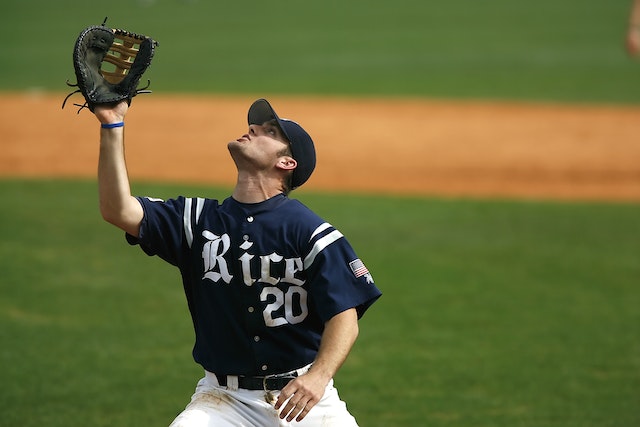
For instance, if you’re in the outfield, and you drop a foul ball that should have been an out, that’s a misplayed foul fly error.
What Is A Tagging Error In Baseball?
A tagging error happens when a fielder tries to tag a baserunner but misses making contact with them or the base. This mistake can have different outcomes. The runner might be considered safe or even get a chance to advance to the next base, depending on what’s happening in the game at that moment.
Here is a classic tag error example
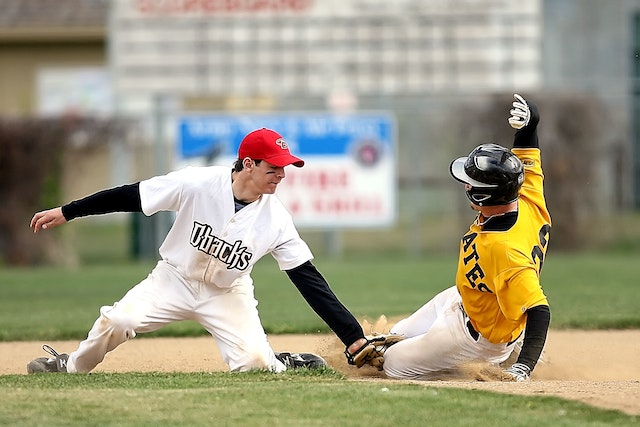
For example, if you’re at first base and catch a throw but don’t step on first base before the batter or runner, that’s a tagging error.
What Is A Throwing Error In Baseball?
Throwing errors occur when a fielder makes a wild throw that allows a runner to advance. Meaning, that if the throw were accurate, the batter or the runner would have been out.
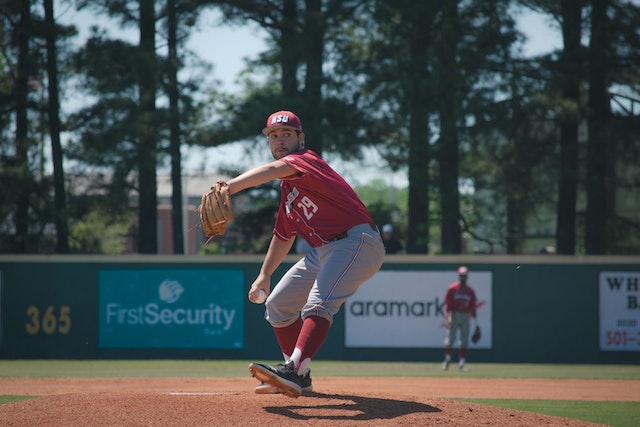
Imagine you’re at third base, and you throw the ball way off target and miss the chance to get a runner out at the home plate. As a result of your throwing error, the runner gets to score.
What Is An Unnatural Bounce or Base Collision Error In Baseball?
If a fielder makes a throw that takes an unexpected bounce or hits someone other than the intended target, that’s an error.
Let’s say you’re the outfielder, and your accurate throw to second base hits the base and bounces away, allowing a runner to advance – that’s an error even if your throw was accurate.
What Is A Failure to Stop Error In Baseball?
If you fail to stop a ball that you should have, and it allows a runner to advance, that’s a failure-to-stop error.
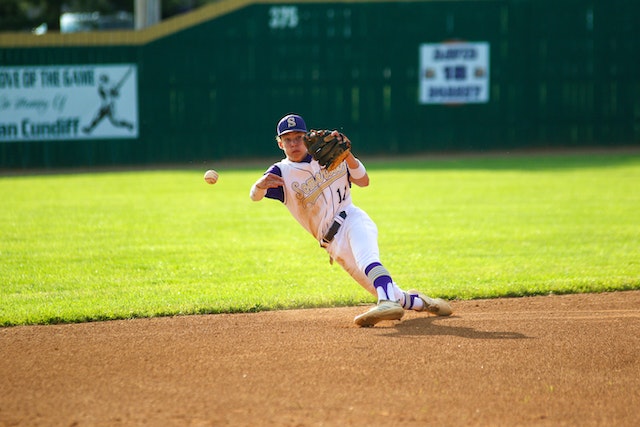
For example, if you’re an infielder, and a ground ball comes your way that you could have stopped but couldn’t, and the runner advances because of it, that’s a failure to stop the ball error.
What Is An Interference or Obstruction Error In Baseball?
When a fielder interferes with or obstructs a batter or runner, that’s an error, and the opposition will be awarded bases according to the official scorer’s judgment.
Imagine you’re at second base, and you obstruct a runner trying to steal – that’s an interference or obstruction error.
So, that was all about the types of baseball errors you might encounter on the field.
However, apart from the above error types, you might have heard a term called “Forced Error” in baseball. Let’s clear up your confusion.
What Is A Forced Error In Baseball?
There is no such thing as a “forced error” in baseball. In baseball, all errors are charged to the fielder who made the mistake, regardless of whether the batter or baserunner caused the mistake.
Now, if you’re wondering if a fielder can make multiple errors in a single play or not, the answer is yes. A fielder can make 2 (known as a double error) or more errors in a single play. Let’s dig this deeper.
What Is A Double Error In Baseball?
A double error in baseball is a situation where two separate errors occur on a single play, leading to extra bases or additional runners advancing.
Let’s say a batter hits a routine ground ball to an infielder, but the infielder first misfields the ball (the first error) and then makes an inaccurate throw to first base (the second error). As a result, the batter reaches second base safely. In this scenario, both the misfield and the errant throw are counted as errors, hence the term “double error.”
[Here’s an interesting fact. On July 27, 1988, Tommy John committed 3 errors in a single play.]
Who Calls Errors In Baseball?
Only the official scorer can call errors in baseball based on his judgment. Not only that, nobody can even challenge or question the decision of the official scorer for calling an error. It is the official scorer’s duty to determine whether a batter reached base on a hit or an error.
Consequences of Errors in Baseball
There can be multiple consequences of errors in baseball. I’m here to break it down for you, just like I would for my own team. So, let’s get into it!
Scoring Consequences
Errors affect the game’s score. When a fielder makes a mistake, the batter can run to bases or even score points.
Imagine a fielder fumbles a ball, allowing the batter to reach second base. That error directly impacted the game by moving the batter forward.
Player’s Standing
Errors can affect a player’s position on the team. If a player keeps making mistakes, they might lose their starting position.
Imagine you’re playing third base, but you keep missing catches. The coach might put someone else in your place.
Special Awards and Honors
Errors matter when players aim for special awards. In big leagues, making too many mistakes can cost a player awards or honors.
Think of it like a race – errors slow you down, and if you want to win a special prize, you need to minimize them.
Detailed Explanations Of Baseball Error Codes By Position
In the Scorebook, Errors are Noted as “E” Plus a Number:
In the official scorebook, when a player makes a mistake, the scorer notes it down using the capital letter “E” followed by a number. This number corresponds to the position that the player is playing on the field.
You know, every baseball position has a specific number assigned to it. Here’s a quick rundown of the position numbers and baseball error codes.
| Position | Position Number | Error Code |
| Pitcher | 1 | E1 |
| Catcher | 2 | E2 |
| First baseman | 3 | E3 |
| Second baseman | 4 | E4 |
| Third baseman | 5 | E5 |
| Shortstop | 6 | E6 |
| Left fielder | 7 | E7 |
| Center fielder | 8 | E8 |
| Right fielder | 9 | E9 |
Now, let’s say the pitcher throws a wild pitch. In the scorebook, the scorer would write “E1” to show that it’s an error by the pitcher. The “E” stands for error, and the “1” corresponds to the pitcher’s position.
But here’s the thing: if there’s a bit of chaos on the field, and multiple players mess up on the same play, the official scorer records each error separately.
For example, if the shortstop makes an error by fumbling the ball, and then the second baseman makes a bad throw, he’d write “E6” for the shortstop’s error and “E4” for the second baseman’s error.
Which Baseball Position Makes the Most Errors?
The “Shortstop” position makes the most errors in baseball. In addition, the third baseman and the center field make a lot of errors as well.
Shortstop:
Suppose you are fielding in the shortstop position. You’re like the defensive captain of the infield. You stand between second and third base.
A lot of action comes your way—fast grounders, tricky pop-ups. Your reactions need to be lightning-quick, and you’ve got to cover a good amount of ground.
Because of this, sometimes errors can happen, like fumbling a grounder or missing a catch due to the speed of the play.
And you’ll find it in reality if you look at the current fielding stats of MLB. As of writing this article, Trea Turner And Cj Abrams top the list with 22 error points.
Third Base:
Now, let’s talk about third base. You’re the hot corner, my friend! Balls come at you fast and furious. Batters hit rockets your way. You need to be super sharp, making split-second decisions. The ball reaches you quickly, and you’ve got to react swiftly.
So, errors can occur – maybe a throw to first goes a bit off target, or a tough liner slips by.
Center Field:
Finally, imagine you’re in center field, the outfield general. You’ve got a lot of ground to cover. Batters can hit the ball far and wide, and it’s your job to chase it down.
Sometimes, those long drives catch you off-guard, or a ball sails over the fence. It’s a position where errors can happen because you’re covering a huge area and dealing with some hard-hitting balls.
How Do Errors Affect Other Statistics In Baseball?
Errors can be very costly in baseball. But how do they affect the game and players?
Let’s break down how errors affect different aspects of baseball:
Impact on Batting Average
Imagine you’re at bat, and you hit a ball to the outfield. The fielder should have caught it, but he dropped it. You made it to first base, but here’s the deal: it doesn’t count as a hit for you.
Your batting average takes a hit because it’s not your credit. The fielder messed up. So, errors in baseball can lower a batter’s batting average. According to a 2017 study, the batting average can drop as much as 18% points due to these errors.
Pitcher’s Earned Run Average (ERA)
Now, think about the pitcher. If a fielder’s error allows a runner to reach base and that runner later scores, it’s not the pitcher’s fault.
So, that run doesn’t count toward the pitcher’s ERA. This means errors don’t hurt the pitcher’s stats.
Post-Error Performance
After an error, things can get interesting. Major league pitchers’ performance varied after errors in 2017. Some teams handled it better than others.
For instance, the Minnesota Twins had a tough time, allowing a .343 batting average right after an error. But the San Diego Padres held opponents to just a .212 average after an error.
Prevention And Reduction Of Errors:
I’ve made every type of error in the book, and let me tell you, they all stink. The best way to avoid errors is to focus on the basics and practice regularly.
Here are the tips I give my players to reduce the number of errors in matches, and they’re proven to work:
Managing Your Mindset
Check Your Expectations: Before you step onto the field, think about what you expect from yourself. Sometimes, our own high expectations can lead to frustration when we don’t meet them. Stay realistic and remember that everyone makes mistakes.
Let Go Quickly: After an error, don’t dwell on it. You’ve got to move on to the next play. Mistakes happen, but you need to make peace with them to stay focused.
Improving Your Skills
Strong Fundamentals: Work on your basic skills. That means practicing things like footwork, glove action, and knowing how to handle different types of balls. Your glove size and how it’s worn matter, too. A well-fitted glove can make a big difference.
If you ask my opinion on the best baseball gloves, here goes the list of my best picks: 10 Best Baseball Gloves to Choose in 2023.
Quality Repetitions: Just like that old saying, “Practice makes a man perfect”. And like other instances, it applies to baseball as well. Don’t just rely on game situations or batting practice. Get repetitions in different positions and levels, from easy to challenging. This will help you build muscle memory and will boost confidence.
Compete in Practice: Make practice harder than the game. Use a stopwatch to add pressure, compete against teammates, and always aim for quick and accurate plays.
Specific Drills: Focus on position-specific drills. For example, third basemen practice picks and tags, shortstops work on double play feeds and pivots, and so on. Tailor your drills to your position.
Mental Toughness: Baseball is as much mental as it is physical. Stay focused, never take a playoff, and anticipate that every ball could come your way.
Bouncing Back After Errors
Finish the Play Smart: If you make an error, don’t compound it by rushing into another mistake. Stay calm and focus on the next play.
Handle Frustration Wisely: It’s okay to be mad or disappointed, but keep it brief. Find a personal phrase or method to let go and refocus quietly.
Stay Eager: Welcome the next opportunity to make a play. See it as a chance to redeem yourself, not a chance to make another error. You know, the ball often finds players who want it.
Anticipate: Before each pitch, think about what you’ll do if the ball comes your way. Consider field conditions, the runner’s speed, and the game situation.
Learn and Stay Confident: After the game, reflect on what went wrong and how you could have done better. Trust yourself to make the right play next time.
So that was all about errors in baseball, but hold on, I’ve gathered some of the most frequently asked questions I get from my students and I think many of them might be on your mind too. So, don’t miss them.
FAQs
1. What Is The Most Common Error In Baseball?
The most common errors in baseball are 1) fielding errors, 2) throwing errors, and 3) tagging errors.
2. Can An Error Be Charged On A Foul Ball?
No, an error cannot be charged on a foul ball unless it’s a dropped foul fly ball that could retire the batter. If a fielder misplays a foul fly ball and drops it, he can be charged with an error. However, if a fielder intentionally lets a foul fly ball drop to prevent a runner from scoring from third base, no error is usually charged.
3. Does An Error Count As An At-Bat?
Yes, an error is considered an at-bat in baseball. When a batter gets on base due to an error by a fielder, it counts as an at-bat for the hitter. However, it doesn’t count as a hit.
4. Does An Error Count As A Plate Appearance?
Yes, errors are counted as plate appearances in baseball. A plate appearance is counted each time a player bats or reaches base on an error.
5. Does An Error Count As An RBI?
No, an error does not count as an RBI. RBIs are mostly credited to a batter when they hit a ball and that allows a runner to advance to home plate and score a run. However, there are exceptions, and a batter is not credited with an RBI if the scored runs are due to errors.
6. Why Are Passed Balls Not Errors?
Passed balls are not errors because it’s a part of pitching and not fielding. And errors in baseball are the mistakes by the fielder, not the pitcher.
7. What Is Error 4 In Baseball?
Error 4 (also known as “E4”) in baseball is the mistakes made by the second baseman that allows a batter or baserunner to advance or reach base, such as mishandling a ground ball or making an errant throw.
8. Is A Balk An Error?
No, a balk is not an error. Errors and balks are distinct in baseball rules. A balk is a specific pitching violation where the pitcher makes an illegal movement or fake while on the mound. It leads to a penalty for the pitcher, such as advancing baserunners but not recorded as an error.
Final Words
We all make mistakes, but in baseball, we strive to minimize them and make those routine plays every time. Focus on the fundamentals, and soon, you’ll be making those plays like a pro.
Until next time, keep practicing to minimize your errors and be confident for your next games.
More Resources
What Does TB Mean In Baseball?
What Is Minor League Baseball?

Hello everyone. My name is Jason Butler, and I live in California, America. I was a professional AAA Minor League Baseball player. I lost my chance of playing MLB for injury issues, but I did not lose my love for baseball. I attended the coaching training program and am now working as a coach in a small school in San Diego.
I always love to share my experience and knowledge if that can help you. Play baseball, and stay fit.
